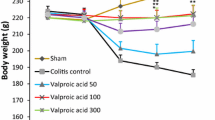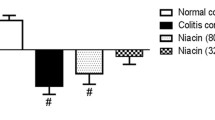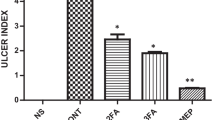Abstract
Ulcerative colitis (UC), limited to the colon’s innermost lining, has become a global health problem. Immunomodulatory and monoclonal antibodies are used to treat UC despite their side effects and limitations. Phenytoin is used to heal wounds owing to its effects on growth factors, collagen, and extracellular matrix synthesis. This study aimed to evaluate the effect of topical phenytoin administration in UC. Phenytoin was administered in two doses during the treatment. Eighty male Wistar rats (230–280 g) were divided randomly into ten groups of sham, control, hydrocortisone, phenytoin 1%, and 3% groups in 6- or 12-day treatment protocols. The UC model was induced by the administration of acetic acid 4% into the colon. Animals were killed on the 7th and 13th postoperative days. The main outcome measures included body weight loss, microscopic score, and ulcer index measured using specific criteria. Growth factors were measured by western blotting. Results illustrated that body weight loss was reversed in the treatment groups. Ulcer index had decreased on 6- and 12-day treatment protocols. Microscopic scores in 6-day enema treatment significantly decreased compared to the control groups. Transforming growth factor-beta (TGFβ) significantly increased in a time-dependent manner and platelet-derived growth factor (PDGF) and vascular endothelial growth factor (VEGF) significantly increased in a time- and dose-dependent manner in phenytoin 1% and 3% in the 6- and 12-day protocols. Phenytoin dose- and time-dependently reversed weight loss. In addition, histopathological parameters included microscopic scores, and the ulcer index was decreased through the induction of growth factors TGFβ, PDGF, and VEGF and consequently accelerated ulcer healing.



Similar content being viewed by others
Availability of data and material
All data and materials are available.
References
Ahmad H, Kumar VL (2018) Pharmacotherapy of ulcerative colitis–current status and emerging trends. J Basic Clin Physiol Pharmacol 29(6):581–592
Arya R, Gulati S (2012) Phenytoin-induced gingival overgrowth. Acta Neurol Scand 125(3):149–155
Baharvand M, Mortazavi A, Mortazavi H, Yaseri M (2014) Re-evaluation of the first phenytoin paste healing effects on oral biopsy ulcers. Ann Med Health Sci Res 4(6):858–862
Boshagh MA, Foroutan P, Moloudi MR, Fakhari S, Malakouti P, Nikkhoo B et al (2019) ELR positive CXCL chemokines are highly expressed in an animal model of ulcerative colitis. J Inflamm Res 12:167
Capasso R, Orlando P, Pagano E, Aveta T, Buono L, Borrelli F et al (2014) Palmitoylethanolamide normalizes intestinal motility in a model of post-inflammatory accelerated transit: involvement of CB 1 receptors and TRPV 1 channels. Br J Pharmacol 171(17):4026–4037
Da Silva VC, De Araújo AA, Araújo DFS, Lima MCJS, Vasconcelos RC, de Araújo Júnior RF et al (2018) Intestinal anti-inflammatory activity of the aqueous extract from Ipomoea asarifolia in DNBS-induced colitis in rats. Int J Mol Sci 19(12):4016
de Bruyn M, Machiels K, Vandooren J, Lemmens B, Van Lommel L, Breynaert C et al (2013) Infliximab restores the dysfunctional matrix remodeling protein and growth factor gene expression in patients with inflammatory bowel disease. Inflamm Bowel Dis 20(2):339–352
Doshi A, McAuley JW, Tatakis DN (2020) Topical phenytoin effects on palatal wound healing. J Periodontol. https://doi.org/10.1002/JPER.20-0340
Feagins LA (2010) Role of transforming growth factor-β in inflammatory bowel disease and colitis-associated colon cancer. Inflamm Bowel Dis 16(11):1963–1968
Firmino F, Almeida AMP, Alves GS, Grandeiro DS, Penna LHG (2014) Scientific production on the applicability of phenytoin in wound healing. Rev Esc Enferm USP 48(1):162–169
Ghapanchi J, Noorani H, Farzin M, Rezazadeh F, Pyrayeh H (2013) Effect of topical phenytoin on chemotherapy-induced oral mucositis. Elixir Dentistry 54:12572–12573
Ihara S, Hirata Y, Koike K (2017) TGF-β in inflammatory bowel disease: a key regulator of immune cells, epithelium, and the intestinal microbiota. J Gastroenterol 52(7):777–787
Kadkhodazadeh M, Khodadustan A, Seif N, Amid R (2012) Short term effect of 1% topical phenytoin suspension on the pain and wound dimensions of donor site after free gingival grafts. Shahid Beheshti Univ Dental J 29(5):366–372
Kato T, Okahashi N, Ohno T, Inaba H, Kawai S, Amano A (2006) Effect of phenytoin on collagen accumulation by human gingival fibroblasts exposed to TNF-α in vitro. Oral Dis 12(2):156–162
Krishnan K, Arnone B, Buchman A (2010) Intestinal growth factors: potential use in the treatment of inflammatory bowel disease and their role in mucosal healing. Inflamm Bowel Dis 17(1):410–422
Kuhn KA, Manieri NA, Liu T-C, Stappenbeck TS (2014) IL-6 stimulates intestinal epithelial proliferation and repair after injury. PLoS ONE 9(12):e114195
Leydon C, Imaizumi M, Bartlett RS, Wang SF, Thibeault SL (2014) Epithelial cells are active participants in vocal fold wound healing: an in vivo animal model of injury. PLoS ONE 9(12):e115389
Meena K, Mohan A, Sharath B, Somayaji S, Bairy K (2011) Effect of topical phenytoin on burn wound healing in rats. Indian J Exp Biol 49(1):56–9.
Minaian M, Ghannadi A, Karimzadeh A (2006) Anti-ulcerogenic effect of ginger (rhizome of Zingiber officinale Roscoe) on cystemine induced duodenal ulcer in rats. Daru J Pharm Sci 14(2):97–101
Minaiyan M, Ghannadi A, Mahzouni P, Nabi-Meibodi M (2009) Anti-ulcerogenic effect of ginger (rhizome of Zingiber officinale Roscoe) hydroalcoholic extract on acetic acid-induced acute colitis in rats. Res Pharm Sci 3(2):15–22
Morgan S, Hooper KM, Milne EM, Farquharson C, Stevens C, Staines KA (2019) Azathioprine has a deleterious effect on the bone health of mice with DSS-induced inflammatory bowel disease. Int J Mol Sci 20(23):6085
Moura FA, de Andrade KQ, dos Santos JCF, Araújo ORP, Goulart MOF (2015) Antioxidant therapy for treatment of inflammatory bowel disease: does it work? Redox Biol 6:617–639
Pagano E, Capasso R, Piscitelli F, Romano B, Parisi OA, Finizio S et al (2016) An orally active cannabis extract with high content in cannabidiol attenuates chemically-induced intestinal inflammation and hypermotility in the mouse. Front Pharmacol 7:341
Pagano E, Romano B, Iannotti F, Parisi O, D’Armiento M, Pignatiello S et al (2019) The non-euphoric phytocannabinoid cannabidivarin counteracts intestinal inflammation in mice and cytokine expression in biopsies from UC pediatric patients. Pharmacol Res 149:104464
Patil V, Patil R, Kariholu P, Patil L, Shahapur P (2013) Topical phenytoin application in grade I and II diabetic foot ulcers: a prospective study. J Clin Diagn Res 7(10):2238
Rashidian A, Muhammadnejad A, Dehpour A-R, Mehr SE, Akhavan MM, Shirkoohi R et al (2016) Atorvastatin attenuates TNBS-induced rat colitis: the involvement of the TLR4/NF-kB signaling pathway. Inflammopharmacology 24(2–3):109–118
Roda G, Marocchi M, Sartini A, Roda E (2011) Cytokine networks in ulcerative colitis. Ulcers. https://doi.org/10.1155/2011/391787
Rodiño-Janeiro BK, Martínez C, Fortea M, Lobo B, Pigrau M, Nieto A et al (2018) Decreased TESK1-mediated cofilin 1 phosphorylation in the jejunum of IBS-D patients may explain increased female predisposition to epithelial dysfunction. Sci Rep 8(1):1–11
Sadeghi N, Mansoori A, Shayesteh A, Hashemi SJ (2020) The effect of curcumin supplementation on clinical outcomes and inflammatory markers in patients with ulcerative colitis. Phytother Res 34(5):1123–1133
Sanchez-Muñoz F, Dominguez-Lopez A, Yamamoto-Furusho JK (2008) Role of cytokines in inflammatory bowel disease. World J Gastroenterol 14(27):4280
Sayar H, Gergerlioglu N, Seringec N, Ozturk P, Bulbuloglu E, Karabay G (2014) Comparison of efficacy of topical phenytoin with hypericin in second-degree burn wound healing: an experimental study in rats. Med Sci Monit Basic Res 20:36
Shaw J, Hughes C, Lagan K, Bell P (2007) The clinical effect of topical phenytoin on wound healing: a systematic review. Br J Dermatol 157(5):997–1004
Şimşek G, Ciftci O, Karadag N, Karatas E, Kizilay A (2014) Effects of topical phenytoin on nasal wound healing after mechanical trauma: an experimental study. Laryngoscope 124(12):E449–E454
Sturm A, Dignass AU (2008) Epithelial restitution and wound healing in inflammatory bowel disease. World J Gastroenterol 14(3):348
Swamy S, Tan P, Zhu Y, Lu J, Achuth H, Moochhala S (2004) Role of phenytoin in wound healing: microarray analysis of early transcriptional responses in human dermal fibroblasts. Biochem Biophys Res Commun 314(3):661–666
Taheri JB, Bagheri F, Mojahedi M, Shamloo N, Nakhostin MR, Azimi S et al (2015) Comparison of the effect of low-level laser and phenytoin therapy on skin wound healing in rats. J Lasers Med Sci 6(3):124
Thakur R, Jain N, Pathak R, Sandhu SS (2011) Practices in wound healing studies of plants. Evid-Based Complement Alternat Med. https://doi.org/10.1155/2011/438056
Turan M, Ünver Saraydýn S, Eray Bulut H, Elagöz S, Çetinkaya Ö, Karadayi K et al (2004) Do vascular endothelial growth factor and basic fibroblast growth factor promote phenytoin’s wound healing effect in rat? An immunohistochemical and histopathologic study. Dermatol Surg 30(10):1303–1309
Valentini L, Schaper L, Buning C, Hengstermann S, Koernicke T, Tillinger W et al (2008) Malnutrition and impaired muscle strength in patients with Crohn’s disease and ulcerative colitis in remission. Nutrition 24(7–8):694–702
Wirtz S, Neurath MF (2007) Mouse models of inflammatory bowel disease. Adv Drug Deliv Rev 59(11):1073–1083
Yang Y, Zhu X, Qin Y, Chen G, Zhou J, Li L et al (2017) The anti-inflammatory effect of guchangzhixie-pill by reducing colonic EC cell hyperplasia and serotonin availability in an ulcerative colitis rat model. Evid-Based Complement Alternat Med. https://doi.org/10.1155/2017/8547257
Acknowledgements
The authors thank the Vice Chancellor’s office for Research Affairs of Kurdistan University of Medical Sciences (Grants Numbers 95/17 and 95/244) for the grants supporting the present study.
Funding
None reported.
Author information
Authors and Affiliations
Corresponding author
Ethics declarations
Conflict of interest
The authors declare that they have no conflict of interest.
Ethics approval
Approved by the research and ethics committee of Kurdistan University of Medical Sciences (Approval ID: IR.MUK.REC.1395.17).
Consent to participate
Not applicable.
Additional information
Publisher's Note
Springer Nature remains neutral with regard to jurisdictional claims in published maps and institutional affiliations.
Esmael Izadpanah and Mohammad Raman Moloudi are co-last authors.
Rights and permissions
About this article
Cite this article
Fattahi, N., Abdolahi, A., Vahabzadeh, Z. et al. Topical phenytoin administration accelerates the healing of acetic acid-induced colitis in rats: evaluation of transforming growth factor-beta, platelet-derived growth factor, and vascular endothelial growth factor. Inflammopharmacol 30, 283–290 (2022). https://doi.org/10.1007/s10787-021-00885-w
Received:
Accepted:
Published:
Issue Date:
DOI: https://doi.org/10.1007/s10787-021-00885-w




